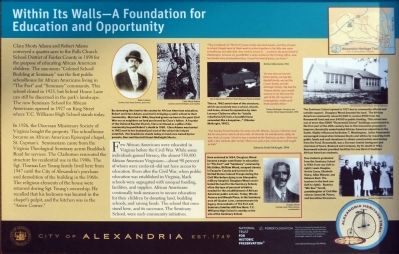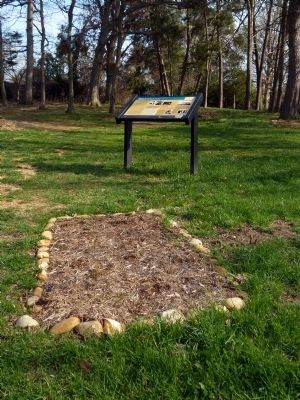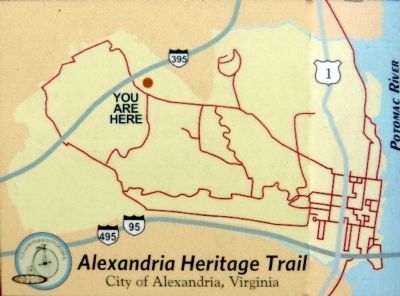Seminary Hill in Alexandria, Virginia — The American South (Mid-Atlantic)
Within Its Walls
A Foundation for Education and Opportunity
Clara Shorts Adams and Robert Adams conveyed a quarter-acre to the Falls Church School District of Fairfax County in 1898 for the purpose of educating African American children. The one-room "Colored School Building at Seminary" was the first public schoolhouse for African Americans living in "The Fort" and "Seminary" community. This school closed in 1925, but School House Lane can still be discerned in the park's landscape. The new Seminary School for African Americans opened in 1927 on King Street where T.C. Williams High School stands today.
In 1926, the Diocesan Missionary Society of Virginia bought the property. The schoolhouse became an African American Episcopal chapel, St. Cyprian's. Seminarians came from the Virginia Theological Seminary across Braddock Road for services. The Claibornes renovated the structure for residential use in the 1940s. The Sgt. Thomas Lee Young family lived here from 1947 until the City of Alexandria's purchase and demolition of the building in the 1960s. The religious elements of the house were retained during Sgt. Young's ownership. He recalled that his bedroom was located in the chapel's pulpit, and the kitchen was in the "Amen Corner. "
(Sidebar)
Few African Americans were educated in Virginia before the Civil War. While some individuals gained literacy, the almost 550,000 African American Virginians—about 90 percent of whom were enslaved—did not have access to education. Even after the Civil War, when public education was established in Virginia, black schools were segregated with unequal funding, facilities, and supplies. African Americans continually took measures to secure education for their children by donating land, building schools, and raising funds. The school that once stood here, and its successor, The Seminary School, were such community initiatives.
“They [residents of “The Fort”] were mostly educated people, and they all went to school, though most of them went to school together in the little one-room schoolhouse, but after that, they went to school or ... worked in the government in Washington, because my grandfather's sister worked at the Printing Office. And her friends were all schoolteachers. It was that kind of group, you know.” — Barbara Ashby Gordon. 1994
“At that time we had the Peters family, we had the Randall family, we had the Craven family, and the McKnight family. We had the Thomas family, and I would venture to say that was the gist of the [St. Cyprian's] congregation, made up of those families there.” — Charles McKnight, Secretary and Sunday School Superintendent, 1992
“Our Sunday School teacher, his name was Mr. Warner ... he was a German man but he was just so nice to all of us kids. All the kids. He was dynamic, really, he was. And, of course, I think he was a student at the Seminary up here ... there was quite a few students after he left. There was quite a few came down and taught us kids.“ — Edmonia Smith McKnight, 1994
Erected by City of Alexandria.
Topics and series. This historical marker is listed in these topic lists: African Americans • Civil Rights • Education. In addition, it is included in the Virginia, The City of Alexandria series list. A significant historical year for this entry is 1898.
Location. 38° 49.778′ N, 77° 6.04′ W. Marker is in Alexandria, Virginia. It is in Seminary Hill. Marker can be reached from West Braddock Road, 0.1 miles east of North Howard Street, on the left when traveling east. Marker is located in Fort Ward Park. Touch for map. Marker is at or near this postal address: 4301 W Braddock Rd, Alexandria VA 22304, United States of America. Touch for directions.
Other nearby markers. At least 8 other markers are within walking distance of this marker. Oakland Baptist Church Cemetery (within shouting distance of this marker); The Oakland Baptist Church (within shouting distance of this marker); Fort Ward (about 400 feet away, measured in a direct line); "The Fort" and "Seminary" Community
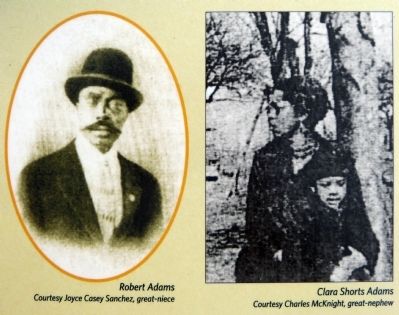
Photographed By Allen C. Browne, April 13, 2014
3. Robert and Clara Shorts Adams
By conveying this land to the county for African American education, Robert and Clara Adams assisted in bringing a public school to their community. Married in 1886, they had grown up here in the post-Civil War era as neighbors on land purchased by Clara's father. A founder of the Oakland Baptist Church, Clara continued as a pillar of the community beyond Robert's death in 1930. Clara Adams was buried in 1952 next to her husband just east of the school she helped establish. Her headstone stands today on land once owned by her parents, Burr and Harriett Stuart McKnight Shorts. Close-up of photo on marker
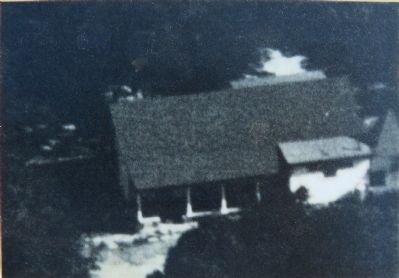
Photographed By Allen C. Browne, April 13, 2014
4. Bungalow, 1962
This ca. 1962 aerial view of the structure, which successively was a school, church, and home, shows its expansion by John Lorenzo Claiborne after “he literally refurbished [it] into a beautiful home somewhat like a bungalow… ” (Charles McKnight, 1992). Close-up of photo on marker
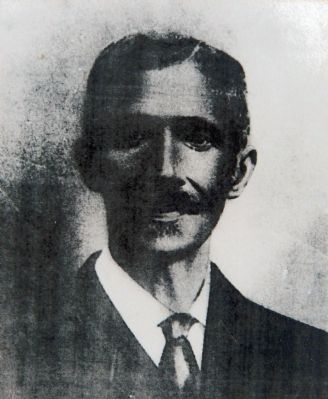
Photographed By Allen C. Browne, April 13, 2014
5. Douglas Ward
Born enslaved in 1854, Douglass Wood became a major contributor to education in “The Fort” and “Seminary” community. His father, William Wood, escaped slavery
in Fauquier County and served in the United States Colored Troops during the Civil War before dying in an Alexandria military hospital. Douglass Wood contributed the land for the Seminary School, often the type of personal initiative needed for the establishment of African American public schools. Today, Woods Avenue and Woods Place, in the Seminary area off Quaker Lane, commemorate his legacy. Descendants of The Fort and Seminary families still live there. T.C. Williams High School is nearby on the
site of the Seminary School. Close-up of photo on marker
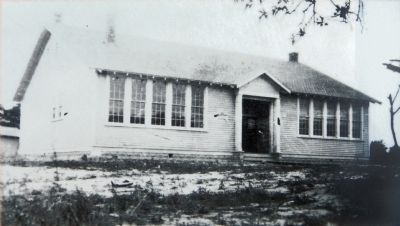
Photographed By Allen C. Browne, April 13, 2014
6. The Seminary School, A Rosenwald School
The Seminary School opened in 1927 due to community efforts and outside support. Douglass Wood donated the land. The African American community raised $1,000 to receive $900 from the Rosenwald Fund and over $4000 in public funding. This school was one of more than 5000 "Rosenwald School" buildings constructed in the first part of the 20th century due to this innovative program to improve chronically underfunded African American education in the South. Highly influenced by Booker T. Washington, Julius Rosenwald encouraged cooperation between blacks and whites by requiring both
public funds and cash donations to obtain construction seed money from the Fund. Rosenwald, was a German-Jewish immigrant and chairman of Sears, Roebuck and Company. By his death in 1932,
Rosenwald schools provided facilities. Close-up of photo on marker
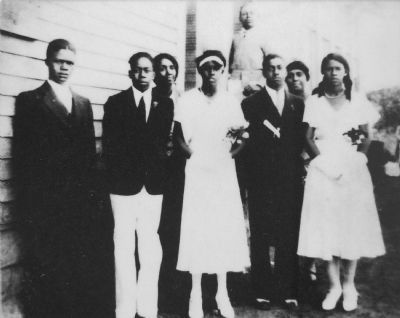
Photographed By Allen C. Browne, April 13, 2014
7. Five Graduates, 1932
Five students graduated from the Seminary School in 1932: front row (left to right): Lewis Douglas, Archie Casey, Elizabeth Henry, Allen Wanzer, and Rebecca Rust. The teachers in the back row (left to right): Beatrice “Miz Sea” Terrell, granddaughter of Civil War veteran James M. Peters, and Geraldine Stevenson. Close-up of photo on marker
Credits. This page was last revised on January 27, 2023. It was originally submitted on March 15, 2015, by Allen C. Browne of Silver Spring, Maryland. This page has been viewed 745 times since then and 19 times this year. Last updated on February 20, 2021, by Carl Gordon Moore Jr. of North East, Maryland. Photos: 1, 2, 3, 4, 5, 6, 7, 8. submitted on March 15, 2015, by Allen C. Browne of Silver Spring, Maryland. • Bernard Fisher was the editor who published this page.
